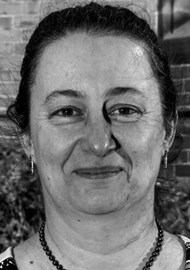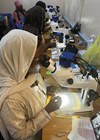Rahila Bashir, Senior Remote Ophthalmic Research Image Grader, talks to Frank Sandi, Ophthalmologist at the Benjamin Mkapa Hospital (BMH), University of Dodoma in Tanzania and to Tunde Peto at Queen’s University Belfast (QUB) and Belfast Health and Social Care Trust (BHSCT).
The history of the Dodoma-Belfast VISION 2020 LINK
In early 2018, the LINK between Dodoma and Belfast was established, with teams of healthcare professionals from both cities forming a health partnership to help meet the objectives of the global initiative ‘VISION 2020: The Right to Sight’ [1].
In June 2018, a team from QUB, accompanied by staff of the VISION 2020 LINKS Programme at the London School of Hygiene & Tropical Medicine (LSHTM), visited Benjamin Mkapa Hospital (BMH) and the University of Dodoma, to establish a VISION 2020 LINK to support the development of local priorities in eyecare.

Initial visit of the team from QUB and LSHTM to Dodoma in June 2018.
VISION 2020 LINKS in Tanzania working together in the Diabetic Retinopathy Network (DR-NET)
The LINK between Dodoma and Belfast is one of four LINKS in Tanzania. The other LINKS are Muhimbili-St Thomas’ Hospital, KCMC-Birmingham and Mbeya-Altnagelvin. All the LINKS in Tanzania are part of the Diabetic Retinopathy Network, DR-NET [2], established in 2014 thanks to funding from the Queen Elizabeth Diamond Jubilee Trust [3]. The DR-NET was established to build DR services in 10 countries through training, capacity-building and development and implementation of national guidelines [4-6].
DR-NET continues to collect data on numbers of patients screened and treated in each participating centre, as well as fostering diabetic eye disease related activities, maintaining close collaboration between centres and enabling further training as and when possible. This has been an amazing resource for the teams in Tanzania and facilitated the development of the national guidelines. For the time being, activities are virtual. Celebrations of World Sight Day on 8 October 2020 included an international virtual workshop showcasing some of the experiences and achievements of DR-NET.
Development of national guidelines
Working together in the Network, with strong support from the Ministry of Health, Community Development, Gender, Elderly and Children, and Dr Bernadetha Shilio in particular, the LINKS helped to facilitate the development of National Diabetic Retinopathy Management Guidelines, launched by Tanzanian Government officials on World Sight Day in 2018. The guidelines emphasised the need to provide the best possible care for people living with diabetes (PLWD). Since the launch of the guidelines nationally in 2018 there has been ongoing CME to update physicians on DR management. The guidelines were disseminated to the National and Regional leaders and later to Regional Eye Care Coordinators, who then cascaded them to lower level health facilities.
The guidelines foster a multidisciplinary team approach. This allows all staff involved, from diabetic eye screening to treatment, to meet on a regular basis and to share case studies for good practice, as well as addressing areas requiring further attention.

Demonstrating how to use Arclight during a dissemination workshop to regional eyecare coordinators.
The guidelines were enthusiastically greeted by those who contributed to them, including Muhimbili National Hospital (MNH) and Kilimanjaro Christian Medical University College (KCMC), where DR services have been established for some time, and the newly-established DR services in Mbeya Zonal Referral Hospital and Benjamin Mkapa Hospital. Bugando Medical Centre in Mwanza is also developing its DR services and hoping to become a VISION 2020 LINK in the near future.
In addition, private hospitals such as Dr Agarwal Eye Hospital (DAEH), International Eye Hospital (IEH) and Comprehensive Community Based Rehabilitation in Tanzania (CCBRT) all signed up for the guidelines. The guidelines are a major step forward for enabling high quality and comprehensive care, provided to consistent standards by all healthcare providers, to all PLWD in Tanzania.
Training visits from Belfast to Dodoma
The University of Dodoma Hospital, the Benjamin Mkapa Hospital, is one of the six referral hospitals in Tanzania and it serves a population of 3.5 million people, which continues to grow as Dodoma consolidates its role as the capital city of Tanzania.

Frank Sandi and Tunde Peto with a happy patient.
The VISION 2020 LINK between Dodoma and QUB has increased knowledge and awareness amongst physicians about diabetic eye screening in PLWD. During training visits by the QUB team, the diabetic eye screening system was strengthened through workshops bringing physicians on board, visiting the dialysis unit, the diabetes clinic and talking to hospital administration to enable more detailed understanding of the current system and how this might be improved over time. Plans are underway to establish treatment services in Dodoma too.
Training visit from Dodoma to Belfast
Through the VISION 2020 LINK and DR-NET, a team from Dodoma visited Belfast, bringing a diabetologist, an ophthalmologist and a Dodoma University representative to see how diabetes and diabetic eyecare services and training are delivered. During the visit, all team members had individualised programmes, and then discussed their findings and how their new learning could be implemented in Tanzania.
Dr Sandi had the opportunity to attend the Five Nations (UK plus the Republic of Ireland) Diabetic Eye Screening Meeting which provided him with an overview of the differences and similarities of the approaches taken to diabetic eye screening in the UK and Ireland.

Signing the MOU during the visit by the Dodoma team to Belfast in October 2018.
World Sight Day celebrations also took place during the visit to Belfast. Dr Sandi gave a well-received lecture on eyecare in Tanzania and specifically DR management capacity building through the LINK. This was a remarkable opportunity for shared learning. The same visit saw the Memorandum of Understanding (MOU) signed by senior management of QUB, BHSCT and Dodoma, formalising the LINK between the two centres.
During the visit the Dodoma team presented diabetic eye screening services in Dodoma to their counterparts in Belfast and discussed the very different prevalence of diabetic eye disease in Tanzania. This included assessment of screening behaviours, population demographics and the increase of diabetes, service structures in clinical settings and an important question: the availability of equipment. Strengthened working relationships with Tanzania Diabetes Association (TDA) and Tanzania Ophthalmology Society (TOS) were also highlighted in the presentation.
Challenges along the way
It is inevitable that during such a project, despite all the effort, hard work and determination, there will be challenges too. The purchase of screening equipment proved to be a long process and is still not quite finished. There is low awareness and understanding of diabetic eye disease amongst PLWD in Tanzania. This leads to diabetic eye disease cases presenting late at the hospital, often resulting in loss of sight in both eyes. Poor coverage of diabetes services across Dodoma, and a lack of data recording in neighbouring regions, contributes to the problems. The team still works with limited screening capacity and a small number of trained screener / graders and limited equipment and supplies. A lack of treatment capacity with no prompt use of laser and relevant accompanying resources has a profound impact on outcomes.
Achievements of the LINK so far
Dr Sandi works as one of the cataract surgeons in the hospital and he reports that his increased experience of diabetic eye disease has allowed him to better triage patients with diabetes and cataracts. The detailed understanding of the interplay between diabetes, diabetic eye disease and cataract led him to present on this topic at DR-NET meetings. He has improved his everyday practice by carefully evaluating all patients with cataract and diabetes so appropriate surgical procedures can be put in place to reduce the risk of complications.
Going forward, a database of patients with diabetes will be established so that systematic follow-up can be put in place. This will serve not only the eye department but also will raise the possibility of closer collaboration with the relevant diabetes services in Dodoma and neighbouring regions as well.
The future is bright!
The year 2020 is a pivotal year for global eye health as it marks the conclusion worldwide of ‘VISION 2020: The Right to Sight’. This year has also witnessed a renewed focus on public health, triggered by the COVID-19 pandemic. In the LINK, while 2019 focused on establishing protocols and processes, training staff and enabling more appropriate use of existing services, 2020 was to shift gear and enable larger numbers of patients to be screened and treated, by procuring a retinal laser machine and starting injections of Avastin for appropriate diabetic eye cases.
While the year 2020 started off promisingly, the COVID-19 pandemic interrupted plans and did not allow this step change to go ahead. In the meantime, WhatsApp communication allows case studies to be discussed and analysed and high-level advice to be given; this method has proved to be a lifeline.

Frank Sandi examining a patient for signs of DR.
Both the Dodoma and the Belfast teams are committed to come out of this challenging period with better understanding of how to use technology for training and exchanging ideas, how to enable closer collaboration with support staff and where new opportunities might be. They continue to work together to bring these changes to life.
While it is unlikely that face-to-face visits will take place in the next few months, both will strive to support each other in the development of the collaboration and will resume travel when allowed. It has been an amazing and rewarding few years for both teams, and both are sure that they will see continuous improvement in diabetic eyecare in Dodoma and its surrounding area in order to prevent blindness and visual loss.
References
1. The International Agency for the Prevention of Blindness. Vision 2020:
www.iapb.org/vision-2020
2. Commonwealth Eye Health Consortium. Diabetic Retinopathy Network:
https://cehc.lshtm.ac.uk/dr-links/drnet
3. The Queen Elizabeth Diamond Jubilee Trust:
www.jubileetribute.org
4. Poore S, Foster A, Zondervan M, et al. Commonwealth nations join forces to prevent blindness from diabetes. Eye News 2015;21(5):33-6.
5. Astbury N, Burgess P, Foster A, et al. Tackling diabetic retinopathy globally through the VISION 2020 LINKS Diabetic Retinopathy Network. Eye News 2017;23(5):30‑4.
6. Zondervan M, Bascaran C, Sandi F, et al. Diabetes and diabetic retinopathy: changes in understanding of the disease over the last 25 years and how the UK is helping low-income countries tackle the challenges. Eye News 2018;25(1):22-8.
(All links last accessed December 2020)
Dr Bernadetha Shilio, National Eye Care Program Manager at the Ministry of Health, Community Development, Gender, Elderly and Children, in Tanzania, said:
“Despite competing priorities in healthcare, Diabetic Retinopathy Services have tremendously increased, this is evidenced by the database available at the National Eye Care Program. There has been an increase in screening and treatment centres from two (in two regions) in 2016, to 10 (in nine regions) in 2020, out of the 26 regions in the country. We thank the VISION 2020 LINKS Programme, DR-NET and the College of Ophthalmology for Eastern, Central and Southern Africa (COECSA) for their support. This investment has touched all the regions of Tanzania.”
COMMENTS ARE WELCOME













